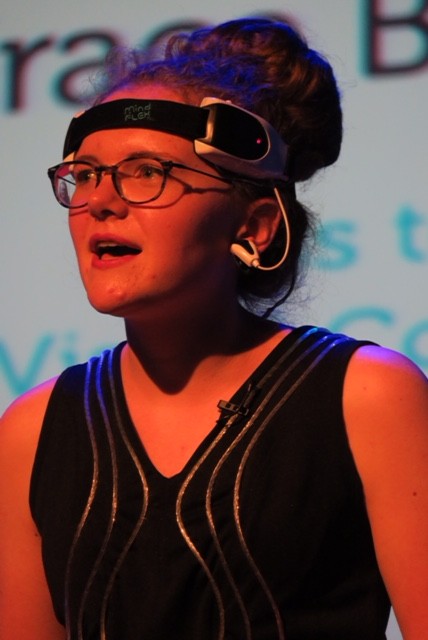A chat with Grace Buckwalter, the brilliant 15-year-old wearable tech inventor
For some people, “fashion” and “neuroscience” are two words that don’t go hand-in-hand.
But those people haven’t met Grace Buckwalter. The 15-year-old student from Lancaster, Pennsylvania is making waves (or should we say brainwaves?) for her project that’s both stylish and brilliant: a dress that changes color based on brain activity.

Via coding, bundles of optic fibers, and a brainwave-reading headset from the game Mindflex, Grace made an outfit that responds to beta and alpha brainwaves. For example, if you’re feeling nervous, some of the optic fibers will turn red. And if you’re feeling relaxed? Then they’ll turn green.
Last year, Grace presented her dress at a TEDx Talk, and also showcased it at the MakerFaire in Queens. She hopes that, eventually, the dress can be used as a warning sign for migraines – a cause that matters deeply to her, since her mother suffers from migraines.
Grace is one of the types of inventors we’re showcasing this Thursday night at our LSC After Dark: Nerd Prom and Wearable Tech Fashion Show event. (Get tickets and read more about the party here!)
As it’s a busy time of year with finals, Grace will not be able to make it on Thursday, but she took some time to chat with us about her dress, her thoughts on the future of wearable tech, and what the word “nerd” means to her.

For your project, you made a dress – an article of clothing many people might not typically associate with “science” or “tech.” Why is it so important your project came in the form of a dress?
There are many forms of wearable technology out there today, and brainwaves an be displayed on any of them. However, I decided to make a dress because it is a traditionally feminine piece of clothing and there are very girls/women in STEAM. By wearing this dress, I am chipping away at the barrier between girls/women and STEAM.
In the future, how do you think wearable technology will detect health problems?
There are already some forms of health-related wearable technology out there, such as the insulin pump for diabetes and fitness watches.
However, there are still many other health problems that could be prevented or assisted with by using wearable technology. If the wearable technology can collect data on the patient at all times, it can use this data to find trends and detect when the health problem may occur.
For example, if a patient has seizures, the patient can wear a piece of wearable technology (perhaps a headband or hat) that collects brainwave data at all times. This data can then be analyzed to detect trends in the brainwaves before, during, and after the seizure occurs.
What else do you think the future of wearable tech looks like?
Very bright, literally. There are so many things you can do with lights and displaying data and this is just the beginning of the wearable technology era. Wearable technology is becoming intertwined in our daily lives more and more.
However, an aspect that must be remembered is that the user must use the data in order for it to be effective.
In your TEDx Talk, you said you want to defy the stereotypical perception of a nerd. Tell me more about that.
First of all, I think that being a nerd isn’t a bad thing and shouldn’t be used to make fun of anyone. By calling someone a nerd, you’re implying that they’re smart, which is a compliment.
However, when you think of a stereotypical nerd, you often imagine a young, white male with glasses and lots of books. I feel like this is not fair because this stereotype doesn’t give credit to everyone who is smart – it only shows a small portion of the geniuses out there. You also can’t assume someone’s depth of knowledge by just looking at them.
By making the point that I’m a nerd and I don’t fit the stereotypes, it shows that the stereotypes are false.
Meet other wearable tech inventors like Grace this Thursday night at #LSCAfterDark: Nerd Prom and Wearable Tech Fashion Show! Get tickets now.
(photos of Grace taken by Mark Usciak)
